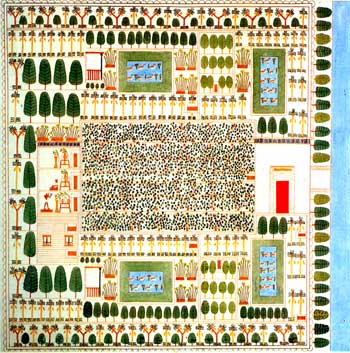
The plan of Sennufer's Garden is the most famous illustration of an Egyptian garden, and the world's oldest accurate plan of a garden
I heard a rumor that Sennufer’s Garden is to be re-created. This is a project I have dreamed of (see note at foot of page on The Domain of Amun) and I believe it is the best tourism investment Egypt could make.
– the project will attract worldwide publicity
– the re-created garden will remind the world that Egypt may well be the country in which the world’s first pleasure garden was made (see blog post Where is the world’s oldest garden?)
– garden visiting is an extremely popular tourist activity, with the Alhambra said to be the most visited garden in Europe
– a new tourist attraction on the East bank in Luxor will take some of the pressure off the ancient monuments on the West bank of the Nile
– a re-created historic garden will fit well with the ambience of the resort hotels being developed on the East bank
I do not know if it has been arranged but the re-created garden is the type of project which could easily attract funding from a hotel chain, an Arab billionaire or from the Aga Khan Historic Cities Support Programme (HCSP) . Since the garden structures would be of mud brick, the cost would not be exorbitant.
The new Sennufer’s garden will be an invaluable contribution to the world’s cultural heritage. If he has a hand in the project, congratulations to Dr. Zahi Hawass (Secretary General, The Supreme Council of Antiquities). A re-creation of the world’s oldest garden would be a wonderful event.
Other Egyptian garden plans survive but Sennufer’s Garden Plan is by far the most sophisticated and in some respects astonishingly modern. See Marie-Luise Gothein’s explanation of the plan of Sennefer’s garden.
[See also: Previous post on Asian gardens and landscapes]

I suppose I was wondering about the high value placed on flowers within gardens which were used symbolically to express meanings rather than for utility – food or medicine.
[http://www.gardenhistoryinfo.com/medieval/pleasuregard.html] Did such associations evolve gradually…or…
Pingback: Indian water gardens history and restoration | Gardenvisit.com Blog
‘When was the world’s first flower garden made?’ is an interesting question. I do not think it was in Sumer. The Ancient Egyptians certainly appreciated flowers but grew them amongst utilitarian plants. So I guess the answer is ‘In Italy’. See http://www.gardenvisit.com/blog/2009/03/09/where-was-the-worlds-first-garden-made/. But the Middle Ages went back to the Egyptian system of growing flowers and utilitarian plants together and flowers were not the main object of either renaissance or baroque gardens. So I guess the modern flower garden comes a bit from the eighteenth century and mostly from the Victorians.
While I was looking to find some information on eighteenth century gardens I found reference to the book ‘Flower Gardens’ by Penelope Hobhouse who is custodian of Tintinhull’s garden on behalf on the National Trust. [http://www.nationaltrust.org.uk/main/w-vh/w-visits/w-findaplace/w-tintinhullgarden/w-tintinhullgarden-seeanddo.htm] From a quick glance at the introductory text she doesn’t say anything about the origins of flower gardens.
Do you have any more info on whether this is actually going to happen or any more links with news about it? Agree this would be great if done well.
Sorry, I have no further information. But if any of our readers know more: please let me know and I will he HIGHLY DELIGHTED to do a post. Leaking and whistle-blowing will be encouraged! – especially from Egyptian sources with information about garden history and design. Anonymity is guaranteed and, if you give permission, so is publicity.
Would you know how one might purchase a large print of this plan. It occurs to me also that this could be a revenue generator for the project. Please pass this on to your anonymous Egyptian sources….
Thank you for a good idea re fund-raising, which I will pass on.
Re the original, I regret that it no longer exists. The original painting was on the ceiling of Tomb 96 in the Western Valley at Luxor. The roof fell in and the painting was destroyed. I cycled up the valley a few years ago to try and find the tomb, without success. The only reproductions of the painting are now in books.
Tom,
Indeed I had read that the original was destroyed (pity). However a detailed copy was made; it is from this reproduction that I assume all the images on the web and in books are generated (no copyright?). I visited an Egyptian exhibit that featured a large reprint (36″x36″), but sadly it wasn’t available for sale. Wonder where I could get a high quality digital image… At any rate, I see that your effort to generate interest is getting some wider play on the internet (http://gardendjinn.typepad.com/garden/desert_gardening/). It would be best to indicate specifically to whom one directs his support for this fabulous concept.
I tracked down the title of the original book about ten years ago but did not succeed in seeing a copy. It must be somewhere in my files! The person ultimately responsible for the project, as for most things to do with Egypt’s antiquities, is Dr. Zahi Hawass, the Director of the Supreme Council of Antiquities for Egypt. His personal website is: http://drhawass.com/ .